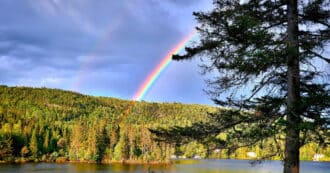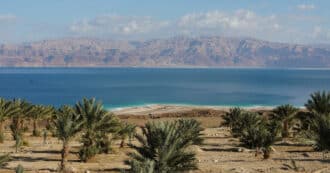By Sydney Cohen – Regeneration ecology was first officially recognized as its own scientific area in the 1990s. The Society for Ecological Restoration describes ecological restoring as supporting the restoring process of damaged, deteriorated, or destroyed systems.
What is Ecological Restoration?
The first step of an ecosystem or landscape restoration project is the clear definition of the project’s goals. Project goals of “restoring native vegetation” or “recover a perturbation environment” are not acceptable. Instead, concrete goals are needed for the restoration, and restoration practitioners “create the conditions needed for recovery so that the plants, animals, and microorganisms can carry out the work of recovery themselves.”
According to the Society for Ecological Restoration, “assisting recovery can be as simple as removing an invasive species or reintroducing a lost species or a lost function (like fire); or as complex as altering landforms, planting vegetation, changing the hydrology, and reintroducing wildlife.”
Principles and Definitions of Ecological Restoration
As previously mentioned, ecological restoration is the process of aiding the recovery of an ecology either degraded or destroyed ecosystems. The aim is to repair the landscape of the environment. In our modern world, ecosystems face three factors – damage, degradation, and destruction.
According to the Society of Ecological Restoration, “damage refers to an acute and obvious harmful impact upon an ecosystem such as selective logging, road building, poaching, or invasions of non-native species.”
“Degradation refers to chronic human impacts resulting in the loss of biodiversity and the disruption of an ecosystem’s structure, composition, and functionality. Examples include long-term grazing impacts, long-term over fishing or hunting pressure, and persistent invasions by non-native species.”
“Destruction is the most severe level of impact, when degradation or damage removes all macroscopic life and commonly ruins the physical environment. Ecosystems are destroyed by such activities as land clearing, urbanization, coastal erosion, and mining.”
Ecological restoration works toward the recovery of an ecosystem, particularly those damaged or destroyed from human activity, through ecological restoration projects, restoration activities, and the practice of conservation.
Restoration ecologists and restoration practitioners use research, science and practice, and restoration science to create conditions needed for recovery to work toward ecosystem restoration. They support the diversity of biological species, aiming for more sustainable natural resources and land use in our future.
Ecological Restoration
The most important goal for ecological restoration is to create a self-supporting ecosystem that is resilient to perturbation and has no more intervention. Restoration of coral reefs seagrass beds and mangrove forests in the tropics is feasible. The difficulty levels are different depending on the various ecosystem types. Mangrove forest is likely the easiest habitat to save, then seagrass beds and finally coral reefs.
An example of a successful restoration on a relatively large scale is the work of Guzman (1991) on the reefs on the Pacific coast of Costa Rica. The reefs had been affected by a combination of natural and human activities that resulted in ecosystem damage.
Restoration Ecology
Restoration ecology is the scientific field that supports the practice and efforts of ecological restoration. The difference between restoration ecology and ecological restoration is that restoration ecology is the research and practices advised for the actual ecological restoration process and projects around the world.
The UN declared 2021-2030 as its Decade of Ecosystem Restoration. During the last few years, commercial applications of eco-restoring have increased exponentially. Habitat loss is causing both species extinction and declining ecosystems.
What Does Ecosystem Restoration Look Like?
Ecological restoration occurs when an action is implemented in the form of new vegetation, grass or other vegetation sown, natural and assisted restoration and agroforestry. The tangible benefits in this decade can therefore be viewed through the lens of the Sustainable Development Goals (SDGs), created by the UN in 2012 at the United Nations World Conference on Sustainable Development.
The world already has millions of hectares of marine and terrestrial forests restored through efforts such as the Global Mangrove Alliance and the Bonn Challenge. There will be additional opportunities for the regeneration of degraded ecosystems around the world.
Socioeconomic Issues of Ecological Restoration
Economic and social problems that afflict most reforestation activities are also problematic. One of the most significant challenges is the economic cost of reforestation. Some landholders would be willing to commit to reforestation in order to conserve biodiversity. However, most of them depend on some form of financial benefits or incentives to assist with the direct or indirect costs accrued in order to carry out the action.
These include supporting monocultural plantations with species-rich buffer strips or plants and varying species for each site depending on the environmental conditions around it. Another possibility consists in building polycultures incorporating a number of different tree and understory species.
The connection between socioeconomic issues and ecological restoration is quite prominent. Ecological restoration processes restore ecosystems so that we can harvest natural resources in sustainable ways. The process of utilizing natural resources boosts the economy in these local communities. However, often the cost to restore ecosystems is quite high and requires significant governmental funding, which is often difficult to acquire.
While ecological restoration benefits the economy in the long run, not only is it a costly endeavor, but it can also be very time-consuming. Consequently, not all communities are willing to commit to the process, given its price and demands.
Society for Ecological Restoration
Ecological restoration has a growing role in the management of environmental degradation. It includes activities related to the recovery of the structure and function of the ecosystem, and corresponding goods and services. Restoration of soil quality together with improved nutrient cycling, water retention pollination services, and regulation of soil erosion is expected to enhance conventional agricultural production. It further enhances access to other important environmental services including clean water, habitat for wildlife, carbon sequestration, and leisure.
Payments for these ecosystem services are growing sources of income for rural inhabitants such as nature-driven tourism, game-hunting, and companies based on native plant materials.
The Society for Ecological Restoration publishes a bi-monthly scientific and peer-reviewed journal, that covers topics of experimental, observational, and theoretical studies, within the field of ecological restoration. The journal addresses global concerns, communicating them to the international practitioner and research communities. You can find the link to the journal here.
It is important that we provide communities access, local and international, to research the information on the process of ecosystem conservation practice, so that the public can learn of the scale of global ecosystem damage, and work to restore it.
The journal provides examples of ecological restoration activities, conservation practices that we can include in our everyday lives, and the important research that practitioners have conducted in order to conserve our resources and support future restoration. This blog post will later highlight some of the practices and steps that we can take to conserve and restore our ecosystems and nature, especially in the wake of climate change.
Ecological Restoration Project Example
The ecological restoration project on Santa Fe island was initiated in 2015 through repopulation with replacement tortoises on Española Island.
A total of 551 ospreys between 5 and 11 years old that translocated from the tortoise breeding program in batches bi-annually have received a total high and steady annual survival rate in juveniles, accelerating the process of establishing a breeding population on the island. This has effectively contributed to the process of restoring the ecological integrity and biodiversity of Santa Fe.
YOU can help!
Fortunately, there are simple changes we can make in our lives and local communities to work toward ecological restoration and conservation of our natural resources.
The most important way to restore our ecosystems is to conserve and use our natural resources sustainably, so as to not further damage or degrade our local ecosystems.
Conservation is an easy action to implement in our daily lives – be it turning off the water while we are brushing our teeth, or even making sure to follow guidelines on “spare the air days” by not lighting fires.
Ecological Restoration for Sustainability
Ecological restoration is important for restoring our ecosystem. It’s not just about conserving the resources we have, but also preventing further damage to our environment and ensuring that future generations will be able to enjoy these natural resources as well.
Restoration Projects as a Spiritual Practice
According to Gretel Van Wieren in Ecological Restoration as Public Spiritual Practice, “we can view restoration not only as a promising contemporary environmental practice, but also as a burgeoning public spiritual practice.” As more and more spiritual communities unite for restoration projects, we will see our planet and our relationship with our Creator transform.
* Featured image source
Follow this link to learn more about ecological balance.








Good insightful information. Hope to learn more about ecological restoration practices and policy framework.